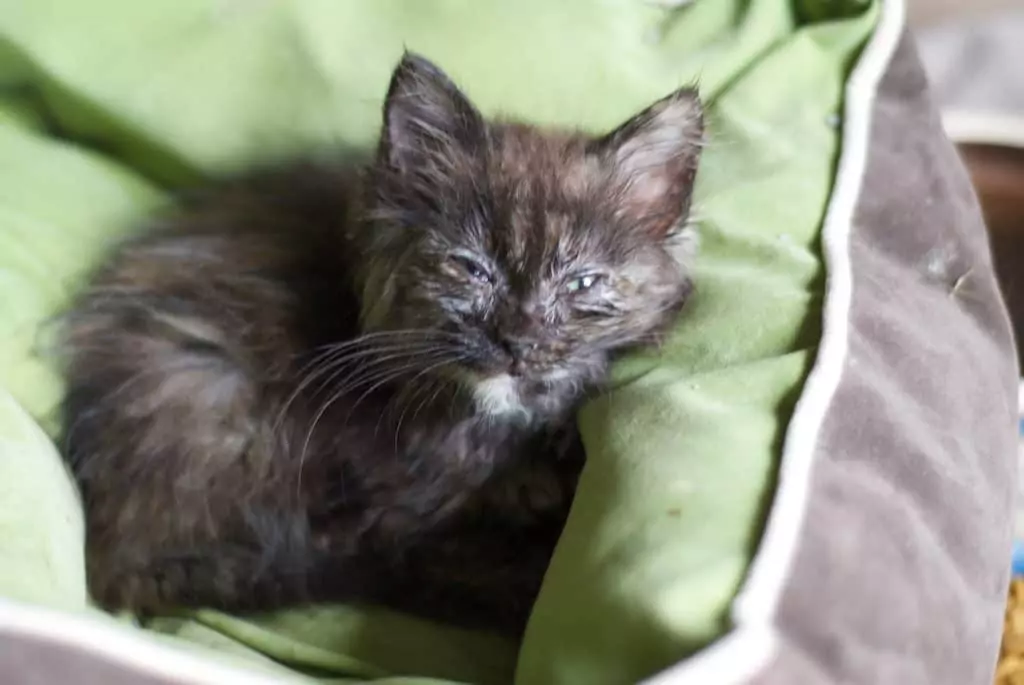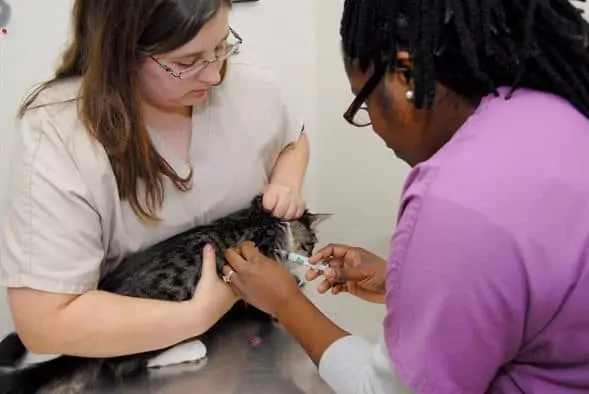The complex of respiratory illnesses in cats includes illnesses that are manifested with mouth cavity ulcerations, salivation, and lacrimation, conjunctivitis, rhinitis, and sinusitis. The most important diseases in domestic and exotic species of cats associated with this complex include FCV (Feline Calicivirus) FVR (Feline Viral Rhinotracheitis, Feline Herpesvirus Type 1), Mycoplasma Felis, and Chlamydia Felis.
FCV and FVR are of far more importance in veterinary medicine, while mycoplasmatic infections and pneumonia in cats caused by Chlamydia Psittaci happen less frequently. One more disease that can be mentioned here is FIP (Feline Infectious Peritonitis) when during the generalized condition some upper respiratory signs of sickness can appear.
FVR is the general cause of upper respiratory infections in cats, but sometimes in a certain population where FCV is more prevalent, this disease can be considered as primary. Of course, joined infections do happen and secondary bacterial infections worsen the situation. It’s important to mention that Feline Calicivirus and Feline Viral Rhinotracheitis don’t pose a threat to human’s health as they are host-specific.

Transmission of Respiratory Illnesses in Cats
Aerosol transmission is the way these infective agents are spread in the environment. The infection occurs with direct contact of a susceptible cat with the infective agents, directly or by a handler. After recovery, the convalescent cats can spread the disease for many months.
FVR is shed intermittently and that makes it hard to determine the exact cause for respiratory signs once we start searching. Calicivirus is easier to detect as it is released continually. The incubation period for both of the viral disease is about a week (two-seven days) and for Chlamydia caused pneumonia is five to 10 days.
Clinical Manifestations
The clinical signs of the diseases resemble most of the respiratory illnesses noted in veterinary medicine. There are some differences between them which will help you in differentiating one from another.
Once the clinical manifestations of an FVR infection start pyrexia, hypersalivation, rhinitis, conjunctivitis, and sneezing (especially after the movement of excitement) become apparent. The initial serous discharge from the nose and the eyes become mucopurulent.
During this time the cat will most likely show signs of inappetence and depression. Rarely, ulcers inside the oral cavity can appear, and sometimes the condition is generalized.

The many strains of caliciviruses in cats can vary from nonpathogenic to pathogenic. Some of them can be the general cause of interstitial pneumonia and pulmonary edema, whilst others can cause hypersalivation and oral and rostral ulcerations.
General symptoms are a febrile state, anorexia, depression, conjunctivitis, stomatitis, ulcerations on the head and bad breath. The symptoms are very similar to FVR and sometimes it is impossible to differentiate them clinically.
A supportive fact is that Calicivirus infections have the potential to damage the lower respiratory tract and the oral mucosa, while Feline Viral Rhinotracheitis potentially affects the nasal passages and the conjunctivae.
It’s interesting that there are two strains of caliciviruses responsible for the limping syndrome in 8-12 weeks old kittens. In this case, besides fever, the cats suffer from leg lameness and pain in the joints. Usually, the kittens recover without treatment and even vaccinated individuals can be affected since there isn’t a commercial vaccine that protects against both of the strains.
Treatment
The treatment for the bacterial part of the complex of respiratory diseases is direct using antibiotics. Antibiotics are also used when the cause is viral agents for fighting secondary bacterial infections, but the general treatment, in that case, consists of symptomatic therapy.
Most recommended antibiotics include cephalosporins, amoxicillin, chloramphenicol, fluoroquinolones, tetracyclines, and trimethoprim-sulfa. For the comfort of the cat, it is recommended to remove the ocular and nasal discharges more frequently. In addition, nasal vasoconstrictors can reduce the secretion of nasal exudates along with antibiotics.
To prevent corneal irritation ophthalmic ointment containing tetracyclines is indicated a couple of times per day. Lysine amino-acid has the ability to interfere with the replication of herpes viruses and can be used PO. Early giving of antihistamines has proved to be beneficial.
More invasive protocols are indicated when the disease progresses rapidly and the clinical signs significantly worsen. When prolonged anorexia is apparent the cat needs to be force-fed, sometimes with using gavage and esophagostomy; oxygen tents are used in cases of severe dyspnea and hypoxia, and in dehydrated individuals I/V fluid therapy is indicated.
Prophylaxis
Vaccines that prevent the occurrence of Feline Viral Rhinotracheitis and Feline Calicivirus are part of the regular vaccination protocols for cats in most parts of the world. There are two types of vaccines – vaccines for parenteral administration and conjunctival/nasal vaccines. 4

The parenteral type consisted of a modified live virus is given twice to cats older than 9 weeks of age in an interval of 21 days. Kittens should receive shots in the interval of 21-28 days until they turn 12 weeks of age. A single-dose booster is indicated every one to three years. The commercial parenteral vaccines usually contain modified live or chemically inactivated FPV (Feline Panleukopenia Virus).
Instillation of vaccine drop into the conjunctiva and the nasal passages is done once if the cat is more than 12 weeks of age. Kittens under this age should receive a second dose once they turn one year. The revaccinations are indicated annually. The veterinarian or vet tech should inform the owners that this type of vaccination can induce sneezing that can last for up to a week.
Chlamydial vaccines are commercially available as single vaccines or in combination with FPV, FVR and FCV.
Besides regular vaccination protocols, successful prevention is achieved when the cat isn’t exposed to sick cats, stray cats and isn’t prone to stress. Overcrowding can be a contributing factor in increased risk of infection.
If you want to read more articles like this, check out the post about the Vaccination Schedule for Cats in Europe on our blog!
You can also watch the video on respiratory infection in cats for more information on this topic.
